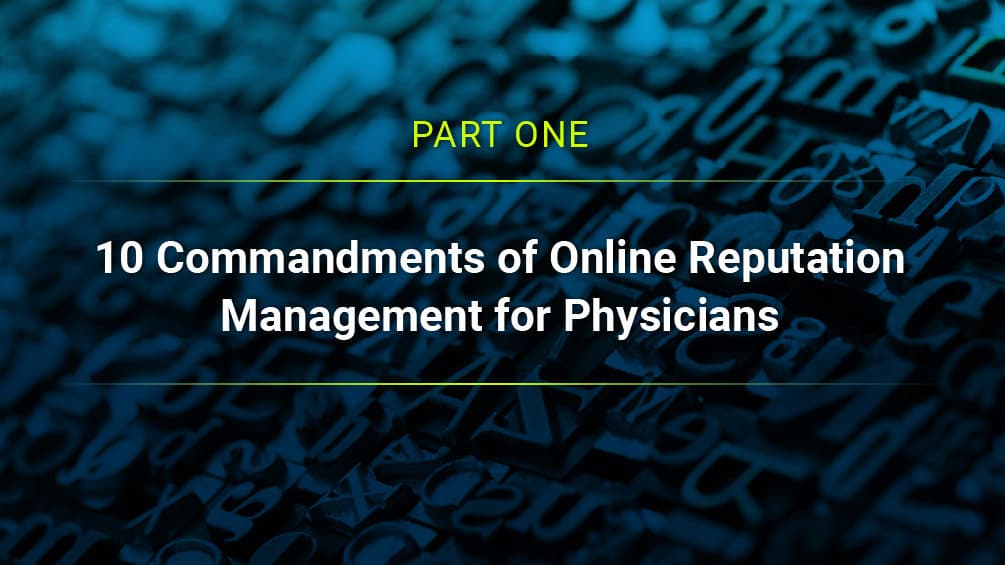10 Commandments of Online Reputation Management for Physicians [Part One]
[First of an article in two parts.]
Across the board, medical reputation management is an ever-present ingredient in healthcare marketing.
Informed and empowered consumer/patients do their homework, researching symptoms, medical conditions and hospitals. From branding to public relations (and everything in between), a physician’s reputation is a key component and influence factor.
And as many as 8 out of ten people will look online for information about individual doctors. And all of that happens long before they make an appointment…and what they find—positive, negative, neutral or nothing at all—influences their decision to call or not to call.
Perception is the reality: Who you are online is who you are to most people.
Many doctors fail to appreciate that their reputations extend far beyond their immediate circle of professional colleagues and current patients. In fact, far more people—the consumer public, prospective patients and many other physicians—know you first (and sometimes exclusively) by your online reputation.
It is the “management” side of Reputation Management that is most often neglected.
A physician carefully stacks the familiar building blocks, carefully aligning data points that include education, training, experience, academic papers, presentations, recognitions, etc.—all the stuff that fills a multi-page Curriculum Vitae (CV). And for the sake of conversation, let's assume the CV is “sterling,” and the provider is a skilled communicator, has a caring “bedside manner,” and is trusted, well-know and well-liked by close colleagues, staff and patients. All good stuff.
The First 10 Rules. (What would you add to this list?)
Although there’s very little cost involved, the Internet has many facets and reputation management requires a systematic commitment of time and effort. (You may want some professional help, particularly to get things going at the outset.) Here are some of the essential concepts for effectively managing your online status:
- Your reputation lives in two places: online and in-person. Pay attention to both daily. Few things have a higher priority for doctors…concern for their professional reputation is hard earned and constantly protected in their daily work. Physicians need no reminder of the “in-person” part. But the “online” part—which is often out-of-sight-out-of-mind—deserves equal concern and attention.
- What’s online can hurt you and it can help you. The Internet is the home of “digital word-of-mouth.” Comments—either good or bad—tend to be seen as a form of endorsement, crowd sourcing, or social proof. Patient recommendations and testimonials can, and often do, significantly influence the decision process and provider selection of other patients.
- The Internet never forgets. Never. It’s frustrating to think that user-generated comments often remain online (and available) even when they are incorrect, inaccurate, and often undated. Because things are “continuously available” online is further reason to keep your figurative stethoscope on this vital sign.
- Proactively work your online presence at least once per week. It’s just good business sense to see yourself as other see you. Carefully examine these primary (and slightly overlapping) information arenas...
Search Engine Results – use a variety of keywords and search with Google, Bing, Yahoo! Search, Ask, Aol Search and others. Pay particular attention to listings or results that have a community connection.
Local Directory Listings – regularly check “find a doctor” sources with online Yellow Pages/SuperPages, business listings, insurance-provider lists, hospital databases, Google Plus pages, community, “area connect” or “city search” directories, medical society listings and the like.
Social Media – Primarily your own faces such as Facebook, LinkedIn, Twitter, YouTube, and blogs. Keep your own material fresh and engaging, and don’t overlook mentions that might appear in the social media platforms of others (such as discussion groups, events, blogs, etc.)
Physician Rating and Review Sites – Compile a list (and check each listing regularly) of online listings. A 2011 study of 4,999 online physician rating sites identified these 10 as the most commonly visited sites with user-generated content: HealthGrades.com, Vitals.com, Yelp.com, YP.com, RevolutionHealth.com, RateMD.com, Angieslist.com, Checkbook.org, Kudzu.com, and ZocDoc.com. (That leaves only 4,989 others.)
CONTINUED NEXT WEEK:
LOOK FOR THE SECOND AND CONCLUDING PART OF THIS ARTICLE.








